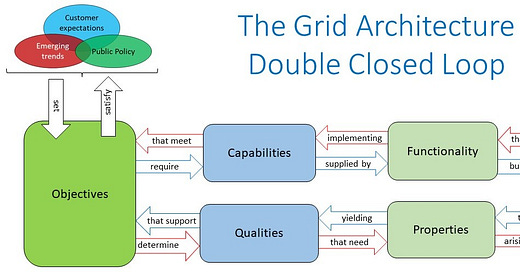The Power Grid Architecture Double Closed Loop
How architectural elements relate to what the grid does to serve the consumers.
In more than 20 years of working on the architectural aspects of power grid modernization, I saw constant confusion about how to connect what the grid was supposed to do and how it was supposed to be arranged to do it. I have boiled all this down to a handful of ideas and a picture that shows how to manage these early issues. I used this approach successfully with many groups working on the grid - it is an example of how the grid architect helps the client navigate vast complexity while not attempting to dictate a solution.
The largest problem with creating a practical grid architecture is generally a failure to delineate four issues:
what the grid is intended to accomplish
what the grid should actually do
how well the grid should be able to operate and serve people
what the architecture actually is and how it relates to the first three issues
Let’s look at the illustration:
The objectives are expressions of what the grid is intended to accomplish. They come from customer expectations, emerging trends (technological, social, economic), and public policy. These driving forces should set the objectives and the objectives should satisfy these driving forces.
Describing what the grid should actually do takes two ideas:
A capability is the ability to perform certain actions or achieve specific outcomes.
Functionality is the group of tasks, operations, or services that a grid can supply or carry out. Functions combine to implement capabilities.
Grouping these properly may need the assistance of the grid architect.
Characteristics describe how well the grid should operate. There are really two kinds of characteristics of the grid and it is important to be able to separate them because they arise from two different points of view. Qualities are grid characteristics seen by and experienced by the users of the grid from the outside. Properties are characteristics seen by the builders and operators of the grid and are primarily internal in nature. For those who are not used to this separation, the grid architect is invaluable in helping to properly group and describe the characteristics that the stakeholders desire.
An architecture is a high level representation of a complex system that enables reasoning about the system’s behavior and performance. It consists of three kinds of things: black box components (meaning we don’t care how the internals work or are implemented), structure (how things are connected or related), and externally visible characteristics. An architecture is a great deal more than just a block diagram. An architectural specification is a set of enforceable guidelines on the overall shape of the grid. It determines the bounds on what the grid can and cannot do.
The illustration above shows how all these elements are related. Note that there are two large colored-outline loops in the diagram - you can start at objectives and follow either large loop in the direction of the colored arrows to read off a sentence that tells how all the parts are related. In fact, for a proper architecture, the two large loops must close in both directions. Hence the name on the diagram. (The small loop between objectives and driving forces must also close).
Messing these things up in the early stages of a grid project is a great way to produce an unworkable architecture, which leads to stranded investments and unrealized benefits. And don’t try to hang the windows first!




